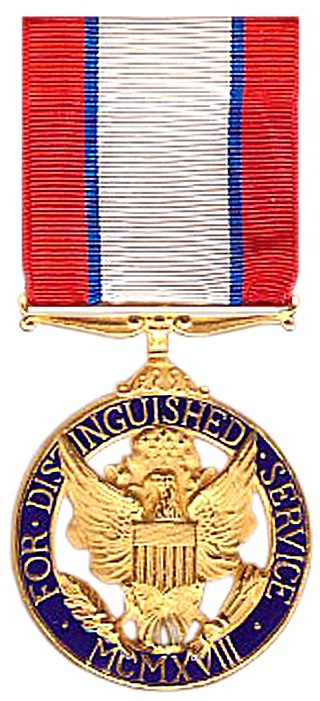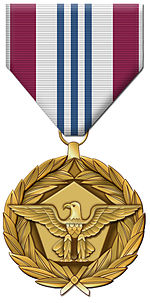
The Bronze Star Medal (BSM) is a United States Armed Forces decoration awarded to members of the United States Armed Forces for either heroic achievement, heroic service, meritorious achievement, or meritorious service in a combat zone.

The Distinguished Service Medal (DSM) is a military decoration of the United States Army that is presented to soldiers who have distinguished themselves by exceptionally meritorious service to the government in a duty of great responsibility. The performance must be such as to merit recognition for service that is clearly exceptional. The exceptional performance of normal duty will not alone justify an award of this decoration.

The Legion of Merit (LOM) is a military award of the United States Armed Forces that is given for exceptionally meritorious conduct in the performance of outstanding services and achievements. The decoration is issued to members of the eight uniformed services of the United States as well as to military and political figures of foreign governments.
The Commendation Medal is a mid-level United States military decoration presented for sustained acts of heroism or meritorious service. Each branch of the United States Armed Forces issues its own version of the Commendation Medal, with a fifth version existing for acts of joint military service performed under the Department of Defense.

The Defense Superior Service Medal (DSSM) is a military decoration of the United States Department of Defense, which is presented to United States Armed Forces service members who perform superior meritorious service in a position of significant responsibility.

MG Alfred A. Valenzuela is a retired United States Army major general who commanded United States Army South (USARSO) at Fort Buchanan, Puerto Rico and San Antonio, Texas.
The Achievement Medal is a military decoration of the United States Armed Forces. The Achievement Medal was first proposed as a means to recognize outstanding achievement or meritorious service of military personnel who were not eligible to receive the higher Commendation Medal or the Meritorious Service Medal.

An oak leaf cluster is a ribbon device to denote preceding decorations and awards consisting of a miniature bronze or silver twig of four oak leaves with three acorns on the stem. It is authorized by the United States Armed Forces for a specific set of decorations and awards of the Department of Defense, Department of the Army, and Department of the Air Force.
A "V" device is a metal 1⁄4-inch (6.4 mm) capital letter "V" with serifs which, when worn on certain decorations awarded by the United States Armed Forces, distinguishes an award for heroism or valor in combat instead of for meritorious service or achievement.

A 5⁄16 inch star (9.7mm) is a miniature gold or silver five-pointed star that is authorized by the United States Armed Forces as a ribbon device to denote subsequent awards for specific decorations of the Department of the Navy, Coast Guard, Public Health Service, and National Oceanic and Atmospheric Administration. A gold star indicates a second or subsequent decoration, while a silver star is worn in lieu of five gold stars.

A service star is a miniature bronze or silver five-pointed star 3⁄16 inch in diameter that is authorized to be worn by members of the eight uniformed services of the United States on medals and ribbons to denote an additional award or service period. The service star may also be referred to as a campaign star or battle star depending on which award the star is authorized for and the manner in which the device is used for the award.

The United Nations Service Medal for Korea (UNKM) is an international military decoration established by the United Nations on December 12, 1950 as the United Nations Service Medal. The decoration was the first international award ever created by the United Nations and recognized the multi-national defense forces which participated in the Korean War.

The Meritorious Service Medal (MSM) is a military award presented to members of the United States Armed Forces who distinguished themselves by outstanding meritorious achievement or service to the United States subsequent to January 16, 1969.
The United States Armed Forces authorize certain medal and ribbon devices that may be worn if authorized on a defined set of United States military decorations and awards. The devices vary between 3⁄16 inch to 13⁄32 inch in size and are usually attached to suspension and service ribbons of medals and to unit award ribbons. The devices are usually made of brass or metal alloys that appear gold, silver, or bronze in color with either a dull or polished look. The devices may denote additional awards of the same decoration or award, an award for valor or meritorious combat service, participation in a particular campaign, periods of honorable service, specific events, and other special meanings. These are sometimes referred to as award devices, but are most commonly referred to in service regulations and Department of Defense instructions simply as "devices" for awards and decorations.

John Harold Tilelli Jr. is a retired United States Army four-star general who served as Vice Chief of Staff of the United States Army from 1994 to 1995; Commanding General, United States Army Forces Command from 1995 to 1996; and Commander in Chief, United Nations Command/Commander in Chief, ROK/United States Combined Forces Command/Commander, United States Forces Korea from 1996 to 1999. He retired from the United States Army on January 31, 2000 and later worked for the USO and The Aerospace Corporation.

Sandra A. Gregory was a brigadier general in the United States Air Force. During her career, Gregory served in a variety of comptroller and administrative staff positions throughout the United States Department of Defense including wing and major command level assignments as well as several Pentagon tours.
Frank A. Cipolla was an American military officer who served as a brigadier general in the United States Army.

The Texas Outstanding Service Medal is the sixth highest military decoration that can be conferred to a service member of the Texas Military Forces. Subsequent decorations are denoted by a bronze or silver twig of four oak leaves with three acorns on the stem device.

The Texas Governor's Unit Citation is the highest unit award of the Texas Military Forces. Subsequent awards are issued by a bronze or silver twig of four oak leaves with three acorns on the stem device.











